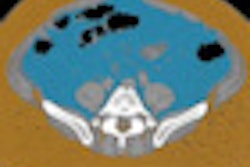CHICAGO - Accumulation of deep visceral fat in men is a risk factor for bone loss and decreased bone strength, which may lead to osteoporosis, researchers reported at the 2012 RSNA annual meeting.
"Our study supports the notion that visceral fat exerts detrimental effects on bone strength," said Dr. Miriam Bredella, an associate professor of radiology at Massachusetts General Hospital/Boston Medical School, at a press conference. "Obese men are not protected against bone loss. Excessive visceral fat -- deep belly fat -- is not only a risk factor for heart disease and diabetes but for also for bone loss."
Visceral fat and osteoporosis has been linked in young women, but no studies have been done in men, Bredella noted.
While increased waist circumference puts men at greater risk for heart disease, Bredella said the only way to determine if a patient has more visceral fat rather than superficial fat is to perform an imaging study that can differentiate the type of fat.
The study included 34 obese but otherwise healthy men with a mean age of 33 years and a mean body mass index (BMI) of 36.5. They were stratified on the basis of visceral adipose tissue.
The researchers used a GE Healthcare LightSpeed CT scanner to perform a single-slice view of the abdomen at the L4 and midthigh to calculate visceral fat, subcutaneous fat, and total adipose tissue.
The bones were analyzed using finite element analysis to assess bone strength and predict fracture risk. It's a technique that is frequently used in mechanical engineering to determine the strength of materials for the design of bridges or airplanes, among other things, according to Bredella.
The 17 men with low visceral adipose tissue had 118.4 cm² of visceral adipose tissue; the 17 men in the high group had an average of 209 cm² of visceral adipose tissue.
The analysis showed that men with higher visceral and total abdominal fat had lower failure load and stiffness, two measures of bone strength, compared to those with less visceral and abdominal fat.
"We found no association between mechanical properties and age, body mass index, abdominal subcutaneous adipose tissue, and thigh subcutaneous tissue," Bredella said.
"Her study tells us that we cannot rely on body mass index alone to determine your risk," said moderator Dr. Judy Yee, chief of radiology at the San Francisco Veterans Affairs Medical Center and vice chair of radiology at the University of California, San Francisco. "With the same BMI you can be at even a higher risk than you think, depending on where the fat is distributed in the body."




















